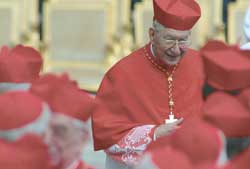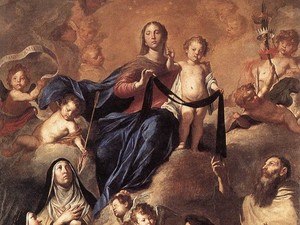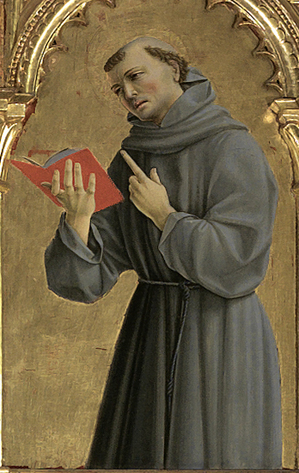
Unless you are clued-in on the Carmelite martyrs, Blessed Teresa of St Augustine and Companions — (d. 1794), also known as the Martyrs of Compiegne, are commemorated today as Virgins and Martyrs. These nuns are the subjects of the opera by François Poulenc, Dialogues of the Carmelites, for which Georges Bernanos provided the libretto.
The 1790 a decree of the new French Republic suppressed all religious communities, except for those engaged in teaching and nursing. You had show the government you were a utilitarian entity that did something for the common good.
July 1794 saw sixteen nuns were arrested on the charge of continuing their illicit way of life. The nuns were “enemies of the people by conspiring against its sovereign rule.” On July 17, 1794, the nuns were taken to the place of execution, all the while singing the Salve Regina and the Te Deum and reciting the prayers for the dying.
Mother Teresa of St. Augustine and companions were beatified in 1906, the first martyrs of the French revolution. The believed what they said: “We are the victims of the age, and we ought to sacrifice ourselves to obtain its return to God.”
It’s important to give the names of the martyrs so as not to forget their history:
Madeleine-Claudine Ledoine (Mother Teresa of St. Augustine), prioress, born in Paris, September 22, 1752, professed 16 or May 17, 1775;
Marie-Anne (or Antoinette) Brideau (Mother St. Louis), sub-prioress, born at Belfort, December 7, 1752, professed September 3, 1771;
Marie-Anne Piedcourt (Sister of Jesus Crucified), choir-nun, born 1715, professed 1737; on mounting the scaffold she said “I forgive you as heartily as I wish God to forgive me”;
Anne-Marie-Madeleine Thouret (Sister Charlotte of the Resurrection), sacristan, born at Mouy, September 16, 1715, professed August 19, 1740, twice sub-prioress in 1764 and 1778. Her portrait is reproduced opposite p. 2 of Miss Willson’s work cited below;
Marie-Antoniette or Anne Hanisset (Sister Teresa of the Holy Heart of Mary), born at Rheims in 1740 or 1742, professed in 1764;
Marie-Francoise Gabrielle de Croissy (Mother Henriette of Jesus), born in Paris, June 18, 1745, professed February 22, 1764, prioress from 1779 to 1785;
Marie-Gabrielle Trezel (Sister Teresa of St. Ignatius), choir-nun, born at Compiegne, April 4, 1743, professed December 12, 1771;
Rose-Chretien de la Neuville (Sister Julia Louisa of Jesus), widow, choir-nun born at Loreau (or Evreux), in 1741, professed probably in 1777;
Anne Petras (Sister Mary Henrietta of Providence), choir-nun, born at Cajarc (Lot), June 17, 1760, professed October 22, 1786.
Concerning Sister Euphrasia of the Immaculate Conception accounts vary. Miss Willson says that her name was Marie Claude Cyprienne Brard, and that she was born May 12, 1736;
Pierre, that her name was Catherine Charlotte Brard, and that she was born September 7, 1736. She was born at Bourth, and professed in 1757;
Marie-Genevieve Meunier (Sister Constance), novice, born May 28, 1765, or 1766, at St. Denis, received the habit December 16, 1788. She mounted the scaffold singing “Laudate Dominum.”
In addition to the above, three lay sisters suffered and two tourieres.
The lay sisters are:
Angelique Roussel (Sister Mary of the Holy Ghost), lay sister, born at Fresnes, August 4, 1742, professed May 14, 1769;
Marie Dufour (Sister St. Martha), lay sister, born at Beaune, 1 or October 2, 1742, entered the community in 1772;
Julie or Juliette Vero-lot (Sister St. Francis Xavier), lay sister, born at Laignes or Lignieres, January 11, 1764, professed January 12, 1789. The two tourieres, who were not Carmelites at all, but merely servants of the nunnery were:
Catherine and Teresa Soiron, born respectively on February 2, 1742 and January 23, 1748 at Compiegne, both of whom had been in the service of the community since 1772.
The miracles proved during the process of beatification were:
The cure of Sister Clare of St. Joseph, a Carmelite lay sister of New Orleans, when on the point of death from cancer, in June, 1897;
The cure of the Abbe Roussarie, of the seminary at Brive, when at the point of death, March 7, 1897;
The cure of Sister St. Martha of St. Joseph, a Carmelite lay sister of Vans, of tuberculosis and an abcess in the right leg, December 1, 1897;
The cure of Sister St. Michael, a Franciscan of Montmorillon, April 9, 1898.



 Today’s feast of Our Lady of Mount Carmel begs us to
Today’s feast of Our Lady of Mount Carmel begs us to

